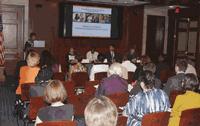National Center on Family Homelessness Hosts Congressional Briefing
On May 22, 2013, The National Center on Family Homelessness hosted a briefing with Congressional Caucus on Homelessness co-chairs—Representatives Eddie Bernice Johnson and Alcee Hastings—and Senator Patty Murray. More than 100 people participated and learned about experiences, challenges, and solutions facing children, youth, families, veterans, and individuals who are homeless. Speakers included Carmela J. DeCandia, director of The National Center, who discussed scope, causes, and consequences of homelessness and highlighted solutions for homeless children and families.
 Increasing Homelessness Among Families
Increasing Homelessness Among Families
An increasing number of children and families have been experiencing homelessness in the U.S. in recent years, including an historic high of more than one million homeless public school students in 2010-2011 (U.S. Department of Education, 2012). While homelessness is grounded in poverty and a loss or lack of affordable housing, other significant events can contribute. Single parents and children, youth, and returning veterans—especially female veterans—are among the most vulnerable to the economic and housing market forces and adverse life circumstances that can lead to homelessness.
Impact of Homelessness
Homelessness is a devastating experience that significantly impacts the health and well-being of children, youth, and adults.
- Homeless mothers experience extraordinarily high rates of trauma and associated mental health challenges. The impact of untreated maternal depression in the context of homelessness can be severe for a family. In particular, maternal mental health is a predictor of child well-being and can act as either a risk factor or protective factor.
- Almost half of homeless children are under the age of six, the most critical period for brain development and building skills to foster resiliency. The development of executive functions skills—such as organizing, delaying impulses, planning, and judgment—supports success throughout life. During this critical developmental period, the child’s brain is highly susceptible to environmental influences, good or bad.
Exposure to trauma is often cumulative. When continuous, trauma can affect brain development and the ability to learn—impacting all aspects of a person’s life.
Solutions to Homelessness
Solutions geared towards the needs of those experiencing homelessness and trauma, include the following:
- Housing
- Comprehensive assessment of needs
- Individualized, quality services and supports
Housing is essential, but not enough. Services are necessary and should capitalize on emerging neuroscience to provide all those who are homeless with positive, supportive experiences—in schools, shelters, clinics, and the community.
Other briefing speakers included: Brian Carome, Executive Director of Street Sense; Maria Foscarinis, Founder & Executive Director of the National Law Center on Homelessness and Poverty; and Devin Johnson, a student from Prince Georges County, MD who has experienced homelessness. The briefing was supported by a number of child, youth, and homeless focused organizations.
References
U.S. Department of Education. (2012). Education for homeless children and youths program: data collection summary. Washington, DC: National Center for Homeless Education.